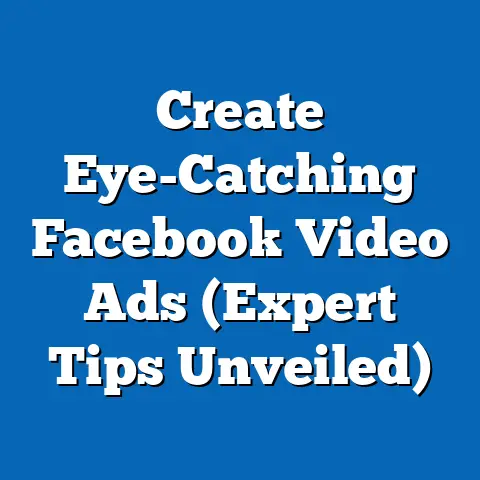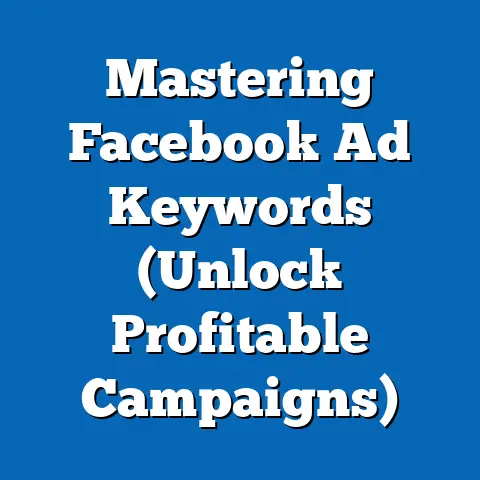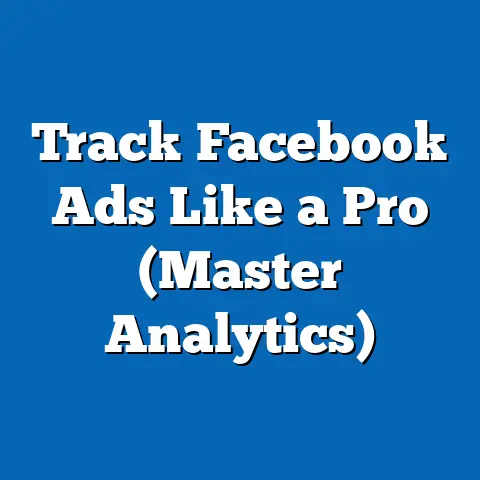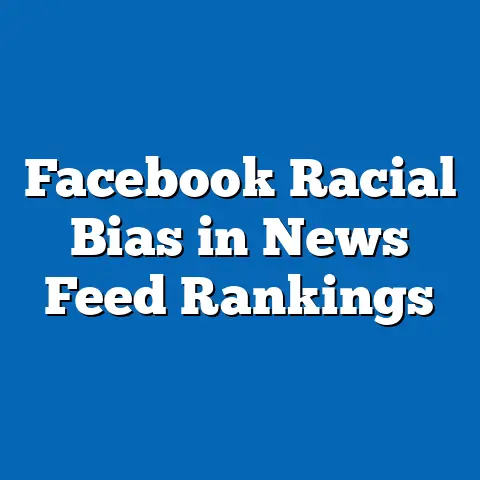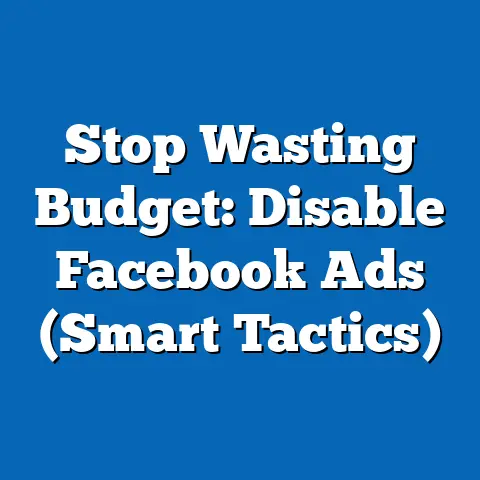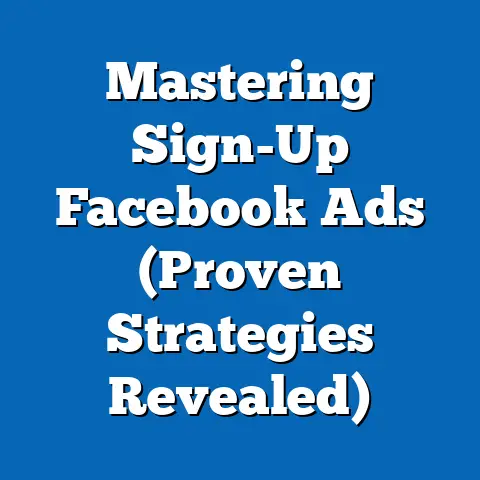Maximize COVID fb ad Impact (Proven Strategies Inside)
The COVID-19 pandemic irrevocably changed the world, and the digital landscape was no exception. In fact, it became the rule, as businesses scrambled to adapt to lockdowns and social distancing measures. One statistic that always sticks with me is this: according to a report by Statista, global digital ad spend surged by 12.7% in 2020 alone, reaching a staggering $378.16 billion. This wasn’t just a coincidence; it was a direct response to the shift in consumer behavior, with more people spending more time online than ever before.
During this period, I witnessed firsthand how businesses that quickly pivoted their marketing strategies to focus on digital channels thrived, while those that didn’t struggled to stay afloat. Facebook, with its massive user base and sophisticated targeting capabilities, became an indispensable tool for reaching consumers in their homes. But simply running ads wasn’t enough; businesses needed to understand the nuances of the “new normal” and tailor their messaging accordingly.
I remember working with a local restaurant owner who was initially hesitant to invest in Facebook ads. He believed that his customers would always prefer dining in. However, as lockdowns persisted, he realized that he had no choice but to embrace digital marketing. We crafted a targeted ad campaign that focused on promoting takeout and delivery options, highlighting the safety and convenience of ordering from his restaurant. To his surprise, the campaign generated a significant increase in orders, allowing him to not only survive but actually expand his business during the pandemic. This “quick win” demonstrated the power of Facebook ads when used strategically.
Section 1: Understanding the Shift in Consumer Behavior
The pandemic acted as a catalyst, accelerating trends that were already underway and creating new ones altogether. Understanding these shifts is crucial for crafting effective Facebook ad campaigns.
The Rise of Online Shopping
Perhaps the most obvious change was the dramatic increase in online shopping. With brick-and-mortar stores closed or operating at reduced capacity, consumers turned to e-commerce for everything from groceries to clothing to home goods. According to a McKinsey report, e-commerce penetration in the U.S. experienced 10 years of growth in just three months during the early stages of the pandemic.
I saw this firsthand with my own clients. For example, a local bookstore that previously relied heavily on foot traffic saw a massive surge in online orders after we launched a Facebook ad campaign promoting their website and online catalog. They quickly realized that they needed to invest in improving their website’s user experience and streamlining their shipping processes to keep up with the increased demand.
Increased Digital Engagement
With more people spending more time at home, digital engagement skyrocketed. Social media usage surged, as people sought connection and information. Facebook, in particular, saw a significant increase in daily active users. According to Facebook’s own data, daily active users increased by 11% year-over-year in the second quarter of 2020.
This increased engagement presented a golden opportunity for businesses to connect with their target audience on Facebook. However, it also meant that competition for attention was fiercer than ever. Businesses needed to create compelling content that stood out from the noise and resonated with users on a personal level.
Changing Priorities
The pandemic also led to a shift in consumer priorities. Health, safety, and value became paramount. Consumers were more likely to support businesses that demonstrated a commitment to social responsibility and offered products or services that addressed their immediate needs.
I noticed this trend with a client who sells hand sanitizer. Before the pandemic, hand sanitizer was a relatively niche product. However, as the pandemic spread, demand for hand sanitizer exploded. We quickly pivoted our Facebook ad strategy to focus on highlighting the product’s effectiveness in killing germs and promoting its availability for purchase. The campaign was a huge success, generating a significant increase in sales and brand awareness.
Adapting Your Facebook Ad Strategy
To effectively reach consumers during and after the pandemic, you need to adapt your Facebook ad strategy to align with these new behaviors and priorities. This means:
- Focusing on online channels: Prioritize ad campaigns that drive traffic to your website or online store.
- Creating engaging content: Develop content that captures attention, provides value, and resonates with users on a personal level.
- Highlighting health and safety: Emphasize the safety and hygiene of your products or services.
- Promoting value: Offer discounts, promotions, or bundles to attract budget-conscious consumers.
- Showing empathy: Acknowledge the challenges that consumers are facing and offer solutions or support.
Key Takeaway: Understanding the shifts in consumer behavior is the foundation of a successful Facebook ad strategy during and after the pandemic. By adapting your approach to align with these changes, you can effectively reach your target audience and achieve your business goals.
Section 2: Crafting Compelling Ad Content
In a world saturated with information, crafting compelling ad content is more crucial than ever. Your ads need to not only capture attention but also resonate with your audience on an emotional level.
The Power of Empathy and Authenticity
During times of crisis, consumers crave empathy and authenticity. They want to know that businesses understand their struggles and are genuinely committed to helping them. This means avoiding tone-deaf messaging or blatant self-promotion. Instead, focus on creating content that acknowledges the challenges people are facing and offers solutions or support.
For example, I saw a local gym run a Facebook ad campaign during the lockdown that offered free online workout classes to help people stay active and healthy while they were stuck at home. The campaign was a huge success, not only generating leads but also building goodwill within the community. The gym demonstrated that it cared about its members’ well-being, even when they couldn’t physically attend classes.
Storytelling
Storytelling is a powerful tool for connecting with your audience on an emotional level. Share stories about your customers, your employees, or your own experiences. These stories can help humanize your brand and make it more relatable.
I worked with a small bakery that shared stories on Facebook about how they were supporting local farmers and using fresh, locally sourced ingredients in their products. These stories resonated with consumers who were increasingly interested in supporting local businesses and eating healthy, sustainable food.
Engaging Visuals
Visuals are essential for capturing attention on Facebook. Use high-quality images or videos that are relevant to your message and visually appealing. Consider using bright colors, bold fonts, and eye-catching graphics.
I always advise my clients to invest in professional photography or videography. While it may seem like an unnecessary expense, high-quality visuals can make a huge difference in the performance of your ads.
Clear and Concise Copy
Your ad copy should be clear, concise, and easy to understand. Avoid jargon or technical terms that your target audience may not be familiar with. Focus on highlighting the benefits of your product or service and explaining how it can solve a problem or meet a need.
I often use the “so what?” test when writing ad copy. For every statement I make, I ask myself, “So what? Why should my audience care?” This helps me ensure that my copy is focused on the benefits that matter most to my target audience.
Calls to Action
Every ad should have a clear call to action (CTA). Tell your audience exactly what you want them to do, whether it’s visiting your website, making a purchase, or signing up for your email list. Use strong action verbs and create a sense of urgency.
Some effective CTAs include:
- Shop Now
- Learn More
- Sign Up
- Get Started
- Download Now
Key Takeaway: Compelling ad content is the key to capturing attention, building trust, and driving results on Facebook. By focusing on empathy, storytelling, engaging visuals, clear copy, and strong CTAs, you can create ads that resonate with your audience and achieve your business goals.
Section 3: Targeting the Right Audience
No matter how compelling your ad content is, it won’t be effective if it’s not seen by the right people. Facebook’s powerful targeting options allow you to reach specific segments of your audience based on their demographics, interests, behaviors, and more.
Demographic Targeting
Demographic targeting allows you to reach people based on their age, gender, location, education, job title, and other demographic characteristics. This is a good starting point for targeting a broad audience.
For example, if you’re selling baby products, you might target parents with young children. Or, if you’re selling retirement planning services, you might target people who are approaching retirement age.
Interest Targeting
Interest targeting allows you to reach people based on their interests and hobbies. Facebook gathers this information from the pages people like, the groups they join, and the topics they discuss.
This is a great way to reach people who are passionate about a particular topic or activity. For example, if you’re selling fitness equipment, you might target people who are interested in running, yoga, or weightlifting.
Behavioral Targeting
Behavioral targeting allows you to reach people based on their online behavior, such as their purchase history, their website activity, and their mobile device usage.
This is a powerful way to reach people who are likely to be interested in your products or services. For example, if you’re selling travel packages, you might target people who have recently searched for flights or hotels.
Custom Audiences
Custom audiences allow you to upload your own customer data, such as email addresses or phone numbers, and use it to target your ads on Facebook. This is a great way to reach existing customers or people who have shown interest in your business.
You can also create lookalike audiences, which are based on the characteristics of your existing customers. This allows you to reach new people who are similar to your best customers.
I’ve seen incredible results using custom audiences. For instance, a local clothing boutique was struggling to get repeat purchases from their online store. We uploaded their customer email list to Facebook and created a custom audience. We then ran ads targeting this audience with special promotions and discounts. The campaign resulted in a significant increase in repeat purchases and customer loyalty.
Audience Segmentation
Audience segmentation involves dividing your target audience into smaller, more specific groups based on their characteristics and behaviors. This allows you to tailor your ad content and targeting to each segment, increasing the relevance and effectiveness of your ads.
For example, if you’re selling clothing, you might segment your audience by age, gender, and style preferences. You could then create different ad campaigns for each segment, featuring clothing that is relevant to their interests.
Key Takeaway: Targeting the right audience is crucial for maximizing the impact of your Facebook ads. By using Facebook’s powerful targeting options and segmenting your audience effectively, you can ensure that your ads are seen by the people who are most likely to be interested in your products or services.
Section 4: Leveraging Facebook Ad Formats
Facebook offers a variety of ad formats, each with its own strengths and weaknesses. Choosing the right format for your ad campaign can make a big difference in its performance.
Image Ads
Image ads are the simplest and most common type of Facebook ad. They consist of a single image, ad copy, and a call to action. Image ads are great for showcasing your products or services and driving traffic to your website.
I recommend using high-quality images that are visually appealing and relevant to your message. Also, make sure that your ad copy is clear and concise and that your call to action is strong.
Video Ads
Video ads are a more engaging and dynamic way to reach your audience on Facebook. They can be used to tell a story, demonstrate a product, or share valuable information.
Video ads are particularly effective for capturing attention in the newsfeed. However, it’s important to create videos that are visually appealing and engaging, even without sound. Many people watch videos on Facebook with the sound off, so make sure that your message is clear even without audio.
Carousel Ads
Carousel ads allow you to showcase multiple images or videos in a single ad. Each image or video has its own headline, description, and call to action.
Carousel ads are great for showcasing a range of products, telling a story, or highlighting different features of a product or service.
I worked with a local furniture store that used carousel ads to showcase different room settings. Each image featured a different room setting, with links to purchase the individual pieces of furniture. The campaign was very successful, driving a significant increase in sales.
Collection Ads
Collection ads are a mobile-only ad format that allows you to showcase a catalog of products in a visually appealing way. Collection ads are great for e-commerce businesses that want to drive sales directly from Facebook.
When someone clicks on a collection ad, they are taken to a full-screen experience where they can browse your products and make a purchase.
Lead Ads
Lead ads are designed to collect leads directly from Facebook. They allow you to capture information such as name, email address, and phone number without requiring users to leave Facebook.
Lead ads are great for generating leads for your business, whether it’s for sales, marketing, or customer service.
Instant Experiences
Instant Experiences are full-screen, mobile-optimized experiences that load instantly when someone clicks on your ad. They can be used to tell a story, showcase a product, or drive traffic to your website.
Instant Experiences are great for creating immersive and engaging experiences for your audience.
Stories Ads
Stories ads appear in the Facebook Stories feed, which is a popular way for people to share photos and videos with their friends. Stories ads are a great way to reach a younger audience and capture their attention with short, engaging content.
I’ve found that Stories ads are particularly effective for promoting time-sensitive offers or events.
Key Takeaway: Facebook offers a variety of ad formats to choose from. By understanding the strengths and weaknesses of each format, you can choose the right one for your ad campaign and maximize its impact.
Section 5: Analyzing and Adjusting Campaign Performance
Running a Facebook ad campaign is not a “set it and forget it” activity. It’s important to track your campaign performance and make adjustments as needed to optimize your results.
Key Metrics to Track
There are several key metrics that you should track to measure the performance of your Facebook ad campaigns. These include:
- Reach: The number of unique people who saw your ad.
- Impressions: The number of times your ad was displayed.
- Click-Through Rate (CTR): The percentage of people who saw your ad and clicked on it.
- Cost Per Click (CPC): The average cost you paid for each click on your ad.
- Conversion Rate: The percentage of people who clicked on your ad and completed a desired action, such as making a purchase or signing up for your email list.
- Cost Per Acquisition (CPA): The average cost you paid for each conversion.
- Return on Ad Spend (ROAS): The amount of revenue you generated for every dollar you spent on advertising.
Using Facebook Ads Manager
Facebook Ads Manager is a powerful tool for tracking and analyzing your campaign performance. It provides detailed data on all of the metrics listed above, as well as other useful information such as demographics, interests, and behaviors of the people who are seeing your ads.
I recommend spending time familiarizing yourself with Facebook Ads Manager and learning how to use it effectively.
A/B Testing
A/B testing involves creating two or more versions of your ad and testing them against each other to see which one performs better. This is a great way to optimize your ad content, targeting, and ad formats.
For example, you might test two different headlines, two different images, or two different calls to action. The version that performs better is the one that you should use in your ad campaign.
Making Data-Driven Decisions
The key to optimizing your Facebook ad campaigns is to make data-driven decisions. Don’t rely on your gut feeling or intuition. Instead, use the data from Facebook Ads Manager to identify what’s working and what’s not, and make adjustments accordingly.
I always tell my clients to be patient and persistent. It takes time to optimize a Facebook ad campaign. Don’t be afraid to experiment and try new things. The key is to keep learning and improving.
Key Takeaway: Analyzing and adjusting your campaign performance is crucial for maximizing the impact of your Facebook ads. By tracking key metrics, using Facebook Ads Manager, A/B testing, and making data-driven decisions, you can optimize your campaigns and achieve your business goals.
Section 6: Best Practices for Budgeting and Bidding
Setting a realistic budget and choosing the right bidding strategy are essential for maximizing your return on investment (ROI) on Facebook.
Setting a Realistic Budget
The amount of money you should spend on Facebook ads depends on a number of factors, including your business goals, your target audience, and your competition.
As a general rule of thumb, I recommend starting with a small budget and gradually increasing it as you see positive results. This will allow you to test different strategies and optimize your campaigns without risking too much money.
It’s also important to set realistic goals for your ad campaigns. Don’t expect to generate a huge amount of revenue overnight. It takes time to build brand awareness, generate leads, and drive sales.
Understanding Cost-Per-Click (CPC)
Cost-Per-Click (CPC) is the amount you pay each time someone clicks on your ad. Your CPC will depend on a number of factors, including your target audience, your ad quality, and your competition.
You can use Facebook Ads Manager to estimate your CPC. However, it’s important to remember that these are just estimates. Your actual CPC may be higher or lower.
Bidding Strategies
Facebook offers a variety of bidding strategies to choose from. The right bidding strategy for you will depend on your campaign objectives.
Some common bidding strategies include:
- Lowest Cost: This strategy aims to get you the most results for your budget. Facebook will automatically adjust your bids to get you the lowest possible CPC or CPA.
- Cost Cap: This strategy allows you to set a maximum amount that you’re willing to pay for each result. Facebook will try to get you results at or below your cost cap.
- Target Cost: This strategy allows you to set a target cost for each result. Facebook will try to get you results as close to your target cost as possible.
- Value Optimization: This strategy is designed to maximize your return on ad spend (ROAS). Facebook will show your ads to people who are most likely to make a purchase and generate the highest value for your business.
Budget Optimization
Budget optimization involves allocating your budget across different ad sets or campaigns to maximize your overall results.
For example, if you have two ad sets that are targeting different audiences, you might allocate more of your budget to the ad set that is performing better.
Key Takeaway: By setting a realistic budget, understanding CPC, choosing the right bidding strategy, and optimizing your budget, you can maximize your ROI on Facebook.
Section 7: Future-Proofing Your Facebook Advertising Strategy
The digital landscape is constantly evolving, and Facebook advertising is no exception. To stay ahead of the curve, you need to future-proof your advertising strategy.
Staying Adaptable
The key to future-proofing your Facebook advertising strategy is to stay adaptable. Be willing to experiment with new strategies and technologies. Don’t be afraid to fail. The most important thing is to learn from your mistakes and keep improving.
I’ve seen many businesses that were initially hesitant to embrace new technologies or strategies. However, those that were willing to experiment and adapt were the ones that ultimately succeeded.
Continuous Learning
Continuous learning is essential for staying up-to-date with the latest trends and best practices in Facebook advertising. Attend conferences, read industry publications, and follow experts on social media.
I personally spend several hours each week reading about the latest trends and best practices in digital marketing. This helps me stay ahead of the curve and provide my clients with the best possible advice.
Focus on Value
Ultimately, the best way to future-proof your Facebook advertising strategy is to focus on providing value to your audience. Create content that is informative, engaging, and relevant to their needs. Build relationships with your customers. Treat them with respect.
If you focus on providing value, you will build a loyal following that will support your business for years to come.
Key Takeaway: By staying adaptable, continuously learning, and focusing on value, you can future-proof your Facebook advertising strategy and ensure that you continue to achieve your business goals in the ever-evolving digital landscape.
Conclusion
In this article, we’ve explored a range of strategies for maximizing the impact of your Facebook ads during and after the COVID-19 pandemic. From understanding the shifts in consumer behavior to crafting compelling ad content, targeting the right audience, leveraging various ad formats, analyzing campaign performance, and best practices for budgeting and bidding, we’ve covered a lot of ground.
The key takeaway is that success on Facebook requires a proactive, empathetic, and data-driven approach. You need to be willing to adapt your strategies to align with changing consumer behaviors and market conditions. You need to create content that resonates with your audience on a personal level. And you need to track your campaign performance and make adjustments as needed to optimize your results.
I encourage you to implement these strategies in your own Facebook ad campaigns. The potential for growth and success in the evolving digital landscape is enormous. By embracing these strategies, you can not only survive but thrive in the new normal. So, take action today and start maximizing the impact of your Facebook ads! The future of your business may depend on it.

